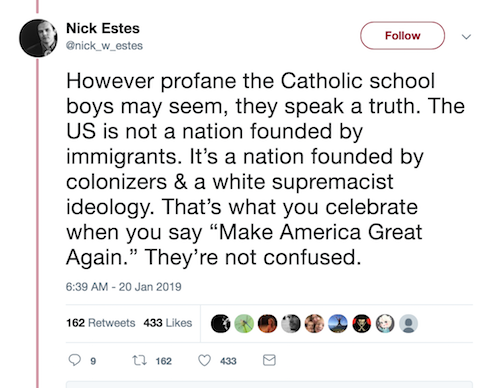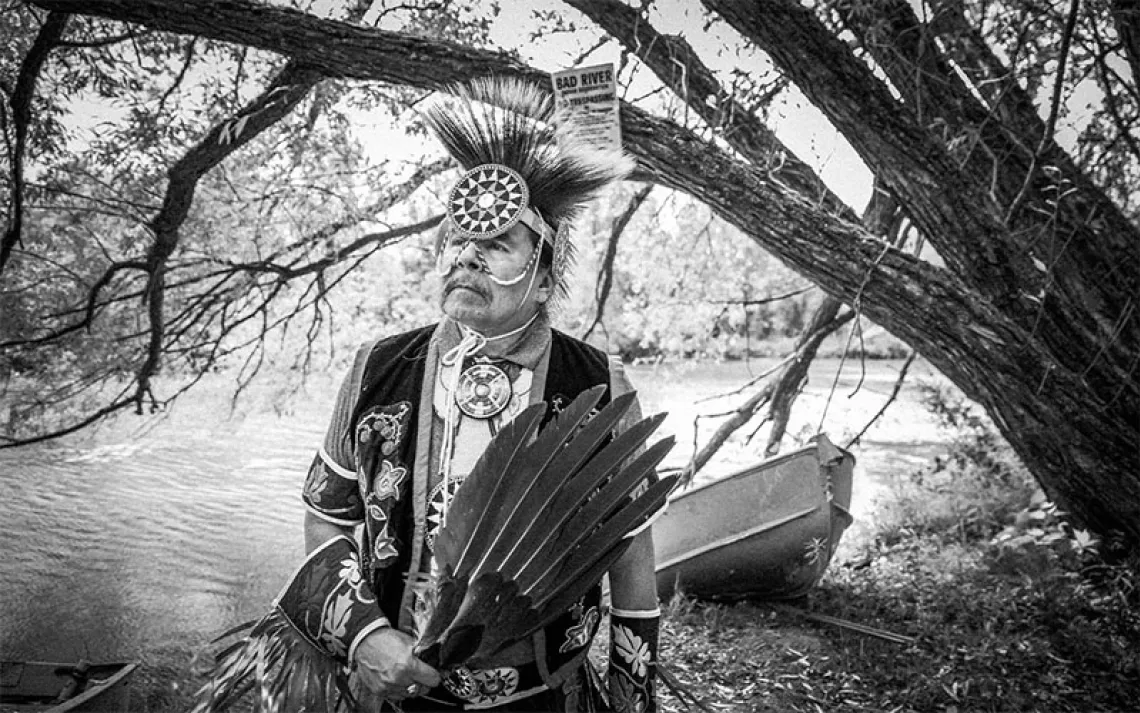“Land Gets Stolen. That’s How It Works.”
What happened at the Lincoln Memorial proves most Americans are still not hearing the Native American experience
By now you have probably seen the disturbing viral video of the January 18 confrontation in which students from a Catholic high school—many wearing Make American Great Again hats—can be seen mocking a Native American elder, Nathan Phillips, as he performs a prayer chant on the steps of the Lincoln Memorial. But you may have missed this outtake from the infamous video, in which an unnamed student from Owensboro (Kentucky) Catholic High School can be heard saying, “Land gets stolen. That’s how it works. It’s the way of the world":
From the mouths of babes comes truth.
The young man’s cavalier statement about genocide and dispossession is the voice of privilege in this country, speaking in unadulterated tones, unleashed by the self-described winner, Donald Trump. This is what the intersection of the fragmented realities of the American experience has wrought: young privileged white men, behaving like latter-day Brett Kavanaughs; black men who have devised a response to overwhelming oppression in a society that values whiteness above all; and rarely seen Native Americans, entering the national dispute only to be rudely dismissed.
The video reveals the triumvirate of experiences that largely define US history—red, black, and white. The question posed by the unspeakable truths uttered in the video is the question that will make or break America: Can we find a way to hear each other?
Since the incident occurred last Friday, a swirl of competing interpretations have emerged about what, exactly, happened at the Lincoln Memorial, and along with it a maelstrom of arguments for what it all means. Here’s what we know about the conflict:
Some videos show that the confrontation began when a group of Hebrew Israelites started shouting at the high school students, who had traveled to Washington, D.C., to attend a “Pro Life” march. But the confrontation was first sparked when the Hebrew Israelites started to sermonize to the Indigenous marchers, telling them that, “You are not savages; you are children of Israel. Stop worshipping totem poles and worship God.”
The speaker goes on to state that the reason Native nations lost their lands is because they stopped worshipping the Creator and worshipped creation instead. A young Native man carrying a staff approaches them and asks them to leave. After being yelled at further, he gives up and walks away.
The Hebrew Israelites (a group of African Americans who believe they are descendants of ancient Israelites) were then confronted by Native women marchers, who explained that they are there for the Indigenous Peoples' March to honor missing and murdered Native American women. When one of the women asked the Hebrew Israelite who they are, the African American man responded that his people are the “real Natives” and that the women are not Indians because an Indian is “a savage.”
What becomes apparent from the video uploaded to YouTube by a member of the Hebrew Israelites is that they are equal opportunity offenders. (To learn more about the group, see this 2011 Village Voice article by Steven Thrasher, which describes their insult-ladden proselytizing in Times Square to tourists and native New Yorkers of every color, ethnicity, and political stripe.) When asked by the Native women why they are mad, one of the Hebrew Israelite men quotes a Bible verse at them: Ecclesiastes 7:7-17, “The Lord says surely your oppression makes a wise man mad.”
After the videos blew up on social media, the March for Life organizers issued a condemnation of the students' behavior—then deleted that statement from their website. The Catholic Diocese of Covington, Kentucky, issued an apology for the boys’ taunting of a Native American elder on the steps of the Lincoln Memorial. But then a parent who chaperoned the school trip posted on social media that his students were surrounded and that they, in fact, were the victims—a narrative that the right-wing media quickly adopted.
For many Native Americans, the incident has served to confirm the white supremacy that has been part of the United States’ DNA since its founding. Nick Estes, a Kul Wicasa (Lower Brule Lakota) author, tweeted, “However profane the Catholic school boys may seem, they speak a truth. The US is not a nation founded by immigrants. It’s a nation founded by colonizers and a white supremacist ideology. That’s what you celebrate when you say ‘Make America Great Again.’ They’re not confused.” When the young man says, “Land gets stolen. That’s how it works,” he is, of course, referring to the United States’ taking of land from Native nations.

Those nations include the Omaha, whose former homelands now largely comprise the state of Nebraska and to which the elder Nathan Phillips belongs. Though some right-wing messaging has tried to vilify Phillips, his response to the incident shows a middle road for how to navigate the storm of controversy. In an interview with CNN, Phillips offers his account of the incident: “They said, ‘Let's go hit the drum, let's go sing, let's reclaim our space here.’ Because this was the Indigenous Peoples' March rally, and when these two groups came together and started that and I was witnessing as it escalated from just two small groups, then the other one just went back and got more people, went back and got more people, went back and got more people until there were over 100 people, maybe 200 young men there facing down what? Four individuals? Why did they need 200 people there other than it's hate and racism?”
Phillips then asks the question that is on many people’s minds, “Where were the chaperones?”
Indeed, the focus needs to be on the white adults’ role in all of this. Why didn’t they separate the students from the verbal assaults of the Hebrew Israelites? Why didn’t they tell their students to move aside to let an elder seeking to de-escalate the situation continue up the memorial stairs? Why didn’t the teachers move the boys from the steps of the Lincoln Memorial off to the side, where their buses would be?
Nick Sandmann, the Covington Catholic High School student wearing a Make America Great Again cap whose standoff with Phillips went viral, claimed in a written statement that he and the other students received permission to counter the diatribe directed at them with a school cheer. Video of the cheer shows students doing the Maori haka, a kind of war dance, and sumo-wrestling-type moves. By their very nature, these are aggressive displays associated with war and fighting. That seems an odd move to de-escalate the situation.
And it raises other questions. For example, why didn’t the teachers understand how inflammatory it would be to wear Make America Great Again hats and sweatshirts at the Lincoln Memorial, a monument to a president who led the United States through the Civil War and the emancipation of the slaves, and paid with his own life? I question the pedagogy of a school that does not teach its students to examine and contextualize their actions.
The whole incident reveals that privileged young white men confronted by an Omaha elder with a drum could only comprehend his presence and his song as a threat—or a joke. One defender of the boys’ actions, writing in the comments section of the news site Cincinnati.com (the Facebook page hosting the comments has since been closed), suggested that perhaps Sandmann and his friends mistakenly thought the Native American man was there to add his culture to their school cheer because the drum was beating in time to their chant. Maybe. If so, then it would suggest that the strange conflation of stereotypes fed by mascotry and Hollywood films was all these boys had to work with to navigate the tense situation.
Given that the boys performing a “tomahawk chop” in Nathan Phillips’s face are still boys, the narrowness of their understanding of Native Americans is a fault that lies with the adults in their lives. And presumably some of those adults have been emboldened by the present occupant of the White House to allow these young men to proclaim their allegiance to an America marked by racism and inequality—an America great for a few, but oppressive to the many.
When a privileged white boy says, “Land gets stolen. That’s how it works”—or when a far less privileged black man says to an Indigenous woman, “The Lord says surely your oppression makes a wise man mad”—these are truths derived from a problematic past.
Forgotten in this whole sorry episode—as Native Americans are so often forgotten by the dominant culture—is the very reason why the Indigenous marchers were there in the first place. They were there to honor the Native women who have been killed or disappeared. They were there to celebrate the historic election of two Native women to Congress—Representatives Deb Haaland of New Mexico and Sharice Davids of Kansas. They were there to call for the passage of the Savanna’s Act, which is meant to help missing and murdered Indigenous women and which a single white man, Republican representative Bob Goodlatte of Virginia, is determined to block.
Some people have criticized Nathan Phillips for being too bold with his walking prayer up the steps of Lincoln Memorial. But boldness is how change happens. For the boys from Covington Catholic, that boldness could have and should have been a lesson. Yet the boys’ teachers and chaperones failed to provide them with the proper training to see that example of courage as anything more than a punchline.
That may be the saddest part of this whole story: Those boys didn’t take even a moment to really listen, and so they failed to learn.
This article has been updated since publication.
 The Magazine of The Sierra Club
The Magazine of The Sierra Club







